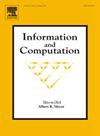Depth-3 circuits for inner product
IF 0.8
4区 计算机科学
Q3 COMPUTER SCIENCE, THEORY & METHODS
引用次数: 0
Abstract
What is the -circuit complexity (depth 3, bottom-fanin 2) of the 2n-bit inner product function? The complexity is known to be exponential for some . We show that the limiting constant satisfies Determining α is one of the seemingly-simplest open problems about depth-3 circuits. The question was recently raised by Golovnev, Kulikov, and Williams (ITCS 2021) and Frankl, Gryaznov, and Talebanfard (ITCS 2022), who observed that . To obtain our improved bounds, we analyse a covering LP that captures the -complexity up to polynomial factors. In particular, our lower bound is proved by constructing a feasible solution to the dual LP.
内积的深度-3 电路
2 位内积函数的电路复杂度(深度 3,底扇形 2)是多少?众所周知,在某个......条件下,复杂度是指数级的。我们证明,极限常数满足 确定是关于深度 3 电路的一个看似最简单的未决问题。这个问题最近由 Golovnev、Kulikov 和 Williams(ITCS 2021)以及 Frankl、Gryaznov 和 Talebanfard(ITCS 2022)提出,他们观察到 .为了得到改进后的下界,我们分析了一种覆盖 LP,它能捕捉到多项式因子的复杂性。特别是,我们的下界是通过构建对偶 LP 的可行解来证明的。
本文章由计算机程序翻译,如有差异,请以英文原文为准。
求助全文
约1分钟内获得全文
求助全文
来源期刊

Information and Computation
工程技术-计算机:理论方法
CiteScore
2.30
自引率
0.00%
发文量
119
审稿时长
140 days
期刊介绍:
Information and Computation welcomes original papers in all areas of theoretical computer science and computational applications of information theory. Survey articles of exceptional quality will also be considered. Particularly welcome are papers contributing new results in active theoretical areas such as
-Biological computation and computational biology-
Computational complexity-
Computer theorem-proving-
Concurrency and distributed process theory-
Cryptographic theory-
Data base theory-
Decision problems in logic-
Design and analysis of algorithms-
Discrete optimization and mathematical programming-
Inductive inference and learning theory-
Logic & constraint programming-
Program verification & model checking-
Probabilistic & Quantum computation-
Semantics of programming languages-
Symbolic computation, lambda calculus, and rewriting systems-
Types and typechecking
 求助内容:
求助内容: 应助结果提醒方式:
应助结果提醒方式:


